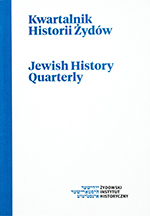Pomiędzy Jerozolimą a Cyrhlą. Przyczynek do badań nad życiem i twórczością artysty malarza Maksa Hanemana (1882–1942?).
Between Jerusalem and Cyrhla. A Contribution to Study of Life and Work of the Painter Maks Haneman (1882–1942?)
Author(s): Katarzyna Chrudzimska-UheraSubject(s): History of Art
Published by: Żydowski Instytut Historyczny
Keywords: Maks Haneman; landscapes; portraits; genre paintings; Orientalism; Jerusalem; Zakopane; national style; identity
Summary/Abstract: The article is about the life and art of Maks Haneman (1882-1942), the painter of landscapes, portraits and genre scenes, active in the first half of the 20th century in the Łódź, Warsaw and Zakopane milieux in the first place. The author embarked on an attempt to verify the factographics and supplement the modest scope of studies on the artist’s career and to define his attitude toward his social and cultural mixed Polish-Jewish roots. In this context, she looks at his travels to the East, which Haneman took both as a beginner (1914) and as fully formed artist (1925). The paintings the trips produced make it possible to identify the various perspectives from which told his stories of the Jewish tradition and modern times. He adopted the point of view of an outside onlooker and at the same time a committed participant, a heir to centuries of tradition and culture. At the same time, already as a student, and especially since settling in Zakopane (1921), he started producing paintings inspired by Tatra Mts. He was the only artists of Jewish descent among Zakopane’s landscape painters. By taking up the Tatra Foothills („Podhale”) themes, Haneman deliberately reached out for forms and themes of an established Polish national character. The painter’s active presence in the life of Zakopane’s “art colony”, shaped back in the 19th century and based on patriotic, independence tradition, confirms the open nature of his artistic and national self-identification, taking both Jewish and Polish sources into account.
Journal: Kwartalnik Historii Żydów
- Issue Year: 280/2021
- Issue No: 04
- Page Range: 929-955
- Page Count: 27
- Language: Polish

